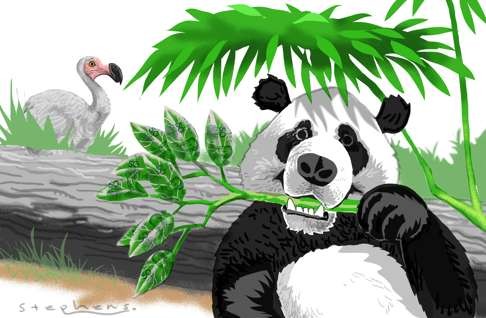
China’s thriving pandas are proof that economic growth is good for the environment
Bjorn Lomborg says endangered species, and nature in general, benefit when prosperity allows humans to think beyond their own survival

Perils facing iconic animals like these have often been used by environmental campaigners to deliver an alarming message: the planet is going to hell in a handbasket. We shouldn’t yet consider pandas completely safe. But there are some clear and perhaps surprising lessons from this and other success stories. Chief among these is that economic growth can be good for endangered species and, more broadly, for the environment.
Giant pandas taken off global ‘endangered’ list as population rebounds
Watch: Cuteness overload as 23 panda cubs make their debut in Chengdu
Yet, it is easy to get the impression that a country getting richer degrades from an idyllic paradise to an industrial wasteland, where pollutants are emitted at will, and endangered animals and native plants are trampled in a race for growth.
Giraffes added to extinction watch list as conservationists warn against ‘dangerous’ complacency
This thinking is showcased by environmental NGO Worldwatch Institute, which claimed in its 2015 “State of the World” report that “economic growth drives most environmental problems” and “growth itself needs to be abandoned as a national goal”.
Watch: Introduction to Worldwatch Institute ‘State of the World 2015’
The truth is that poverty is often a driver of environmental harm. If a country is poor, it can ill afford cleaner technology or investment in cleaning up. The most polluted places on Earth are almost invariably the poorest.
The truth is that poverty is often a driver of environmental harm
As industrialisation starts, some environmental problems get worse. Consider air pollution, by far the biggest environmental killer in the world.
China, home to the giant panda, has seen much higher levels of outdoor air pollution since its rapid industrialisation. In 1990, annual outdoor air pollution deaths stood at almost 600,000, but these have increased to 900,000.

With increasing incomes, far fewer households have to resort to burning wood and coal to cook and keep warm. This has reduced annual deaths from indoor air pollution, from 1.1 million in 1990 to 800,000 today. In total, air pollution deaths have remained fairly constant. Taking into account China’s much larger population today, the risk of dying from air pollution has actually decreased in the country, and this is because of increasing wealth.
Surveys show that, as the Chinese become richer, they are also becoming more concerned about the environment
At the same time, increasing prosperity has helped people in many other ways. China has lifted 800 million people out of poverty since 1978. The proportion of young people in higher education has jumped from 1.8 per cent to 20 per cent, and life expectancy has increased by 10 years to reach 75.
It turns out this is also good news for the panda. As the nation focuses less on surviving, and more on other issues, it will care more for the environment. Surveys show that, as the Chinese become richer, they are also becoming more concerned about the environment.
For the forests where the panda lives, we see a similar trend. As countries get richer, they stop deforesting and start reforesting. Denmark was once naturally covered in forest, but farming cut this back to as little as 2-3 per cent in 1800. Denmark later became wealthy enough to focus on reforestation, and today forests cover 14 per cent of the land.
And China is already making progress: since 1990, forested area has increased by as much as 33 per cent.

After uproar in China, rare animals to remain off the menu
Greater environmental concern has made it easier for the Chinese government to lead panda preservation efforts, not just by protecting forests, but also by increasing the number of panda reserves and creating “corridors” where isolated wild panda populations can mix and strengthen the gene pool.
The panda has acted as an ‘umbrella species’. Save the panda and you can save others
This is not just beneficial for the photogenic bears. While there are concerns that Chinese reforestation is not yet as diverse as it needs to be, researchers at Duke University have found that 70 per cent of the country’s forest mammals, 70 per cent of forest birds and 31 per cent of forest amphibians all live within the panda’s geographic range and the reserves that have been set aside to protect them.
In other words, the panda has acted as an “umbrella species”. Save the panda and you can save others.

Two young female pandas complete ‘survival training’ ahead of release into the wild
Getting richer has similarly allowed other countries to focus on helping struggling species. Singapore’s otters returned, for instance, thanks to extensive water clean-up efforts that an impoverished nation would not have been able to afford.
The next time a panda video goes viral, we should be grateful not just for the animal’s cuteness, but also for the human-powered economic development that has made their rebound possible.
And as pandas take a step further away from extinction, we should pay heed to the lessons learned so we can write even more success stories.
Bjorn Lomborg is director of the Copenhagen Consensus Centre, author of “The Skeptical Environmentalist”, “Cool It”, and “The Nobel Laureates’ Guide to the Smartest Targets for the World 2016-2030”, and a visiting professor at Copenhagen Business School
